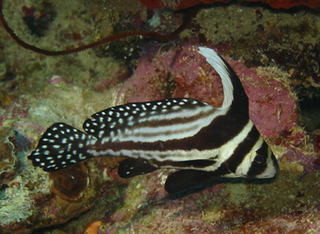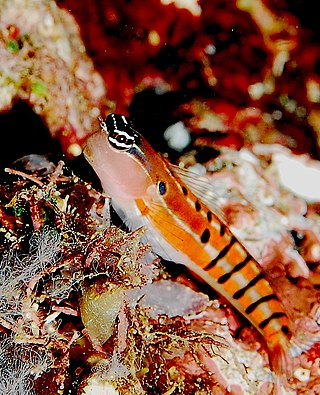
Acanthemblemaria spinosa, the spinyhead blenny, is a species of blenny native to the tropical western Atlantic Ocean and Caribbean Sea.

The slippery dick is a species of wrasse native to shallow, tropical waters of the western Atlantic Ocean.

The spotted drum or spotted ribbonfish, is a species of marine ray-finned fish belonging to the family Sciaenidae, the drums and croakers. This species is found in the western Atlantic Ocean.

Pomacanthus semicirculatus, also known as the semicircled angelfish, Koran angelfish, blue angelfish, zebra angelfish or half-circled angelfish, is a species of ray-finned fish, a marine angelfish, in the family Pomacanthidae. It is found in the Indo-West Pacific Ocean. It occasionally makes its way into the aquarium trade.

Haemulon vittatum, the boga, is an ocean-going species of grunt native to the western Atlantic Ocean. Bogas are also known as the snit in Jamaica, and bonnetmouth in the Bahamas. It was first described by Cuban zoologist Felipe Poey. This species used to be classified as Inermia vittata, but genetic data revealed that it belongs to the genus Haemulon.
Emmelichthyops atlanticus, the bonnetmouth, is a marine fish species of grunt native to the western Atlantic Ocean, where it occurs from Florida and the Bahamas to northern South America. This species is the only known member of its genus.

The Australian blenny is a small marine blennioid fish of the genus Ecsenius. They are small and reddish brown with a white ventral side. Australian blennies inhabit the shallow marine waters of the tropics. They are often found along the Great Barrier Reef and Coral Sea of Australia.

The seaweed blenny is a species of combtooth blenny found in coral reefs in the western Atlantic Ocean along the coasts of New York, Bermuda, the Bahamas, also in the Gulf of Mexico, south to southern Brazil. This species reaches a length of 8.5 centimetres (3.3 in) TL.

Ecsenius axelrodi, known commonly as the Axelrod's clown blenny or the Axelrod's combtooth blenny, is a species of ray-finned fish in the family Blenniidae, the combtooth blennies. It is found in shallow water on coral reefs in the western central Pacific Ocean. It was first described by Victor Gruschka Springer in 1988 and named in honour of the American ichthyologist Herbert Richard Axelrod.

Stanulus talboti, Talbot's blenny, is a species of combtooth blenny found in coral reefs in the western Pacific Ocean. This species feeds primarily on plants, including benthic algae and weeds. This species can reach 4.8 cm (1.9 in) in TL. This fish is also found in the aquarium trade.

Acanthemblemaria maria, the secretary blenny, is a species of chaenopsid blenny found in shallow seas in the western central Atlantic Ocean and the Caribbean Sea. It can reach a maximum length of 5 cm (2.0 in) TL.

The yellowface pikeblenny is a species of chaenopsid blenny found in coral reefs in the western central Atlantic, including the Bahamas and Caribbean. It can reach a maximum length of 8.5 centimetres (3.3 in) TL. This species feeds primarily on crustaceans, finfish, and worms and can be found in the commercial aquarium trade. The specific name honours the zoologist, diver and underwater photographer Conrad Limbaugh (1925-1960).
Chaenopsis resh is a species of chaenopsid blenny found in coral reefs around Venezuela and Colombia, in the western central Atlantic Ocean. It can reach a maximum length of 13 centimetres (5.1 in) TL.
Gobioclinus gobio is a strictly marine ray finned fish, also called Gobioclinus gobio. Its common name is the palehead blenny, and is sometimes referred to as the goggle-eye blenny. It can be identified by its greenish top, red belly, and multicolored banding. L. gobio is a benthic organism with a wide range, taking up residence in a number of coastal environments from Florida to Brazil. This means the fish can live in equatorial, subtropical, and tropical climatic zones. It is native to coastal areas of the Caribbean. Its diet consists mainly of different molluscs and echinoderms.

Paraclinus grandicomis, the horned blenny, is a perciform marine species of labrisomid blenny native to reefs of the Atlantic Ocean and the Caribbean Sea. It is a benthic fish so it cruises along above the sandy or rocky seabed and foraging for crustaceans.

Starksia atlantica, the smooth-eye blenny, is a species of labrisomid blenny native to the western central Atlantic Ocean and the Caribbean Sea where it inhabits coral reefs at depths of around 8 metres (26 ft).

Elacatinus evelynae, commonly known as the sharknose goby, Caribbean cleaner goby, or Caribbean cleaning goby, is a species of goby native to the Western Atlantic Ocean from the Bahamas and the Lesser Antilles to the northern coast of South America, as well as the Antilles and western Caribbean.

Sparisoma aurofrenatum is a species of parrotfish native to the Caribbean Sea and Western Atlantic Ocean.

The Spanish flag is a species of marine ray-finned fish, a grouper from the subfamily Epinephelinae which is part of the family Serranidae, which also includes the anthias and sea basses. It is found in the western Atlantic Ocean. It is the only species in the genus Gonioplectrus.

The rainfordia, also known as the flathead perch or Rainford's perch, is a species of marine ray-finned fish, related to the groupers and classified within the subfamily Epinephelinae of the family Serranidae. It is found in the eastern Indian Ocean and in the Western Pacific Ocean. It is the only species in its monotypic genus.


















